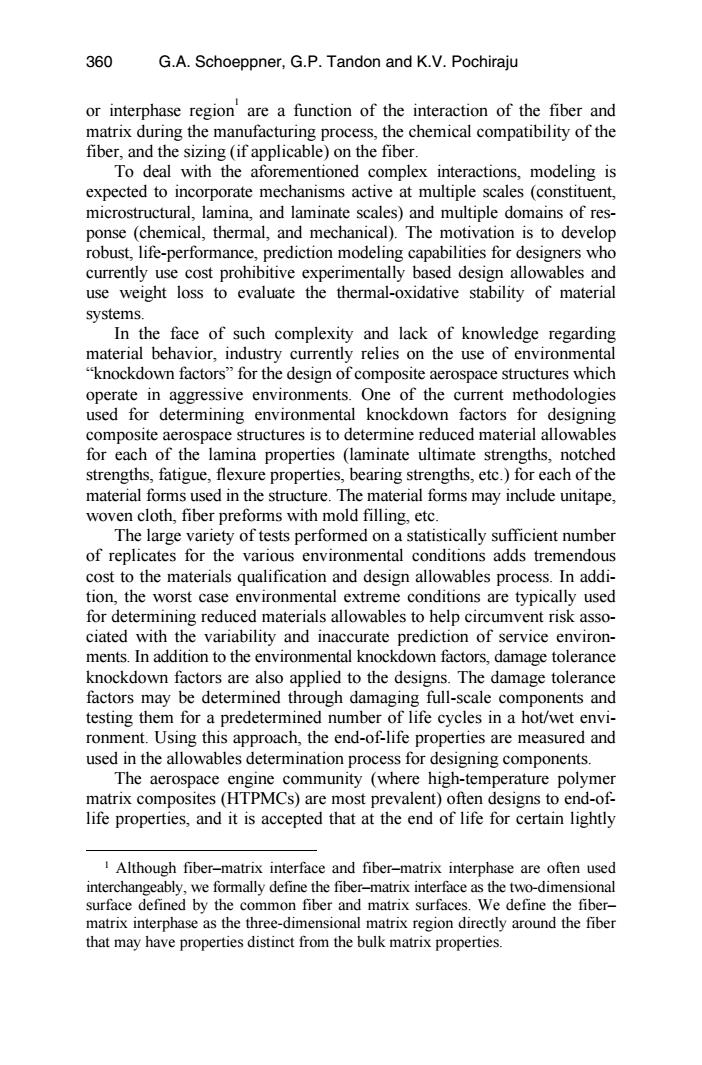正在加载图片...

360 G.A.Schoeppner,G.P.Tandon and K.V.Pochiraju or interphase region are a function of the interaction of the fiber and matrix during the manufacturing process,the chemical compatibility of the fiber,and the sizing(if applicable)on the fiber. To deal with the aforementioned complex interactions,modeling is expected to incorporate mechanisms active at multiple scales (constituent, microstructural,lamina,and laminate scales)and multiple domains of res- ponse (chemical,thermal,and mechanical).The motivation is to develop robust,life-performance,prediction modeling capabilities for designers who currently use cost prohibitive experimentally based design allowables and use weight loss to evaluate the thermal-oxidative stability of material systems. In the face of such complexity and lack of knowledge regarding material behavior,industry currently relies on the use of environmental "knockdown factors"for the design of composite aerospace structures which operate in aggressive environments.One of the current methodologies used for determining environmental knockdown factors for designing composite aerospace structures is to determine reduced material allowables for each of the lamina properties (laminate ultimate strengths,notched strengths,fatigue,flexure properties,bearing strengths,etc.)for each of the material forms used in the structure.The material forms may include unitape, woven cloth,fiber preforms with mold filling,etc. The large variety of tests performed on a statistically sufficient number of replicates for the various environmental conditions adds tremendous cost to the materials qualification and design allowables process.In addi- tion,the worst case environmental extreme conditions are typically used for determining reduced materials allowables to help circumvent risk asso- ciated with the variability and inaccurate prediction of service environ- ments.In addition to the environmental knockdown factors,damage tolerance knockdown factors are also applied to the designs.The damage tolerance factors may be determined through damaging full-scale components and testing them for a predetermined number of life cycles in a hot/wet envi- ronment.Using this approach,the end-of-life properties are measured and used in the allowables determination process for designing components. The aerospace engine community (where high-temperature polymer matrix composites(HTPMCs)are most prevalent)often designs to end-of- life properties,and it is accepted that at the end of life for certain lightly I Although fiber-matrix interface and fiber-matrix interphase are often used interchangeably,we formally define the fiber-matrix interface as the two-dimensional surface defined by the common fiber and matrix surfaces.We define the fiber- matrix interphase as the three-dimensional matrix region directly around the fiber that may have properties distinct from the bulk matrix properties.or interphase region1 are a function of the interaction of the fiber and matrix during the manufacturing process, the chemical compatibility of the fiber, and the sizing (if applicable) on the fiber. To deal with the aforementioned complex interactions, modeling is expected to incorporate mechanisms active at multiple scales (constituent, microstructural, lamina, and laminate scales) and multiple domains of response (chemical, thermal, and mechanical). The motivation is to develop robust, life-performance, prediction modeling capabilities for designers who currently use cost prohibitive experimentally based design allowables and use weight loss to evaluate the thermal-oxidative stability of material systems. In the face of such complexity and lack of knowledge regarding material behavior, industry currently relies on the use of environmental “knockdown factors” for the design of composite aerospace structures which operate in aggressive environments. One of the current methodologies used for determining environmental knockdown factors for designing composite aerospace structures is to determine reduced material allowables for each of the lamina properties (laminate ultimate strengths, notched strengths, fatigue, flexure properties, bearing strengths, etc.) for each of the material forms used in the structure. The material forms may include unitape, woven cloth, fiber preforms with mold filling, etc. The large variety of tests performed on a statistically sufficient number of replicates for the various environmental conditions adds tremendous cost to the materials qualification and design allowables process. In addition, the worst case environmental extreme conditions are typically used for determining reduced materials allowables to help circumvent risk associated with the variability and inaccurate prediction of service environments. In addition to the environmental knockdown factors, damage tolerance knockdown factors are also applied to the designs. The damage tolerance factors may be determined through damaging full-scale components and testing them for a predetermined number of life cycles in a hot/wet environment. Using this approach, the end-of-life properties are measured and used in the allowables determination process for designing components. The aerospace engine community (where high-temperature polymer matrix composites (HTPMCs) are most prevalent) often designs to end-oflife properties, and it is accepted that at the end of life for certain lightly 1 Although fiber–matrix interface and fiber–matrix interphase are often used interchangeably, we formally define the fiber–matrix interface as the two-dimensional surface defined by the common fiber and matrix surfaces. We define the fiber– matrix interphase as the three-dimensional matrix region directly around the fiber that may have properties distinct from the bulk matrix properties. 360 G.A. Schoeppner, G.P. Tandon and K.V. Pochiraju